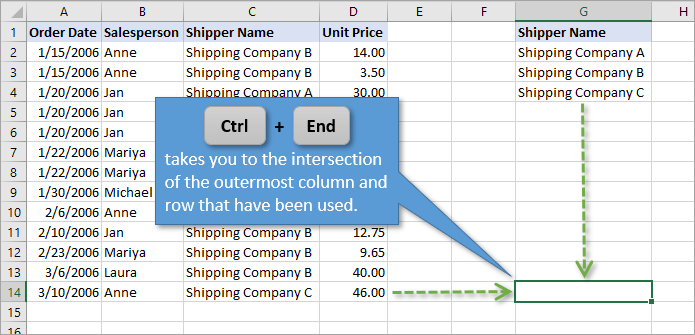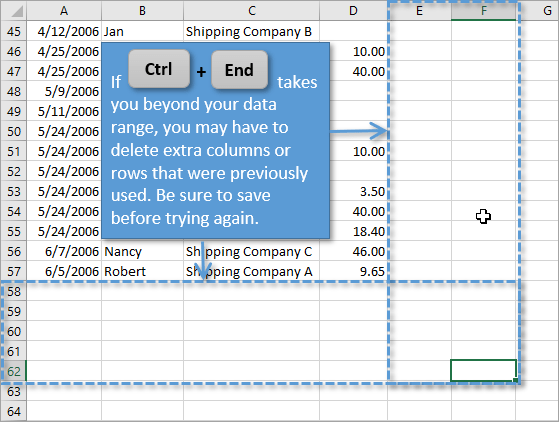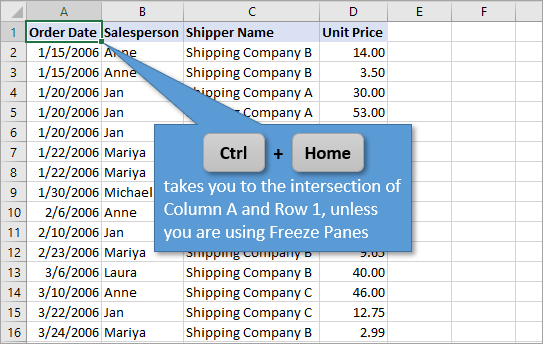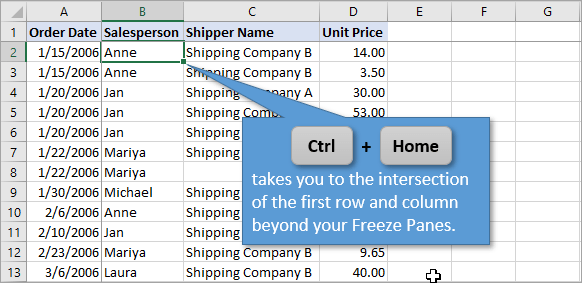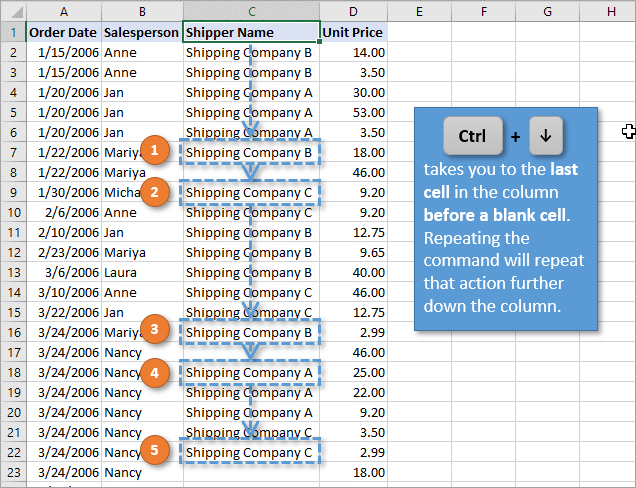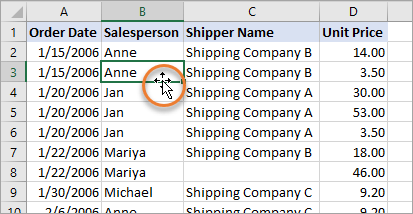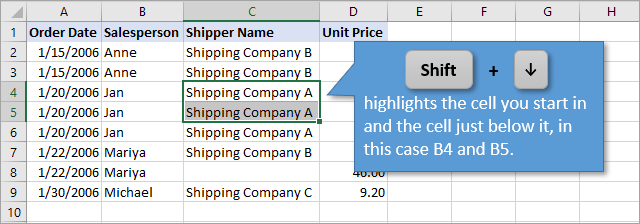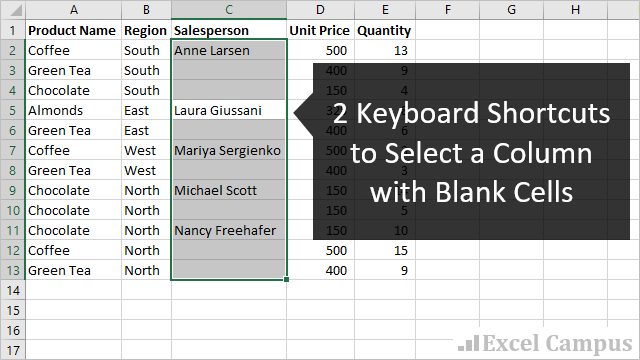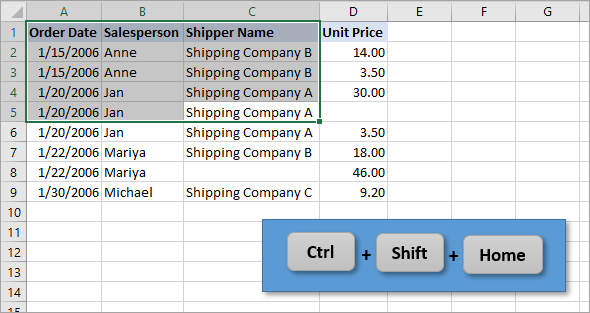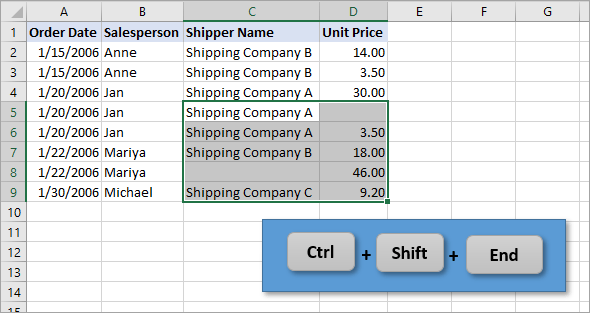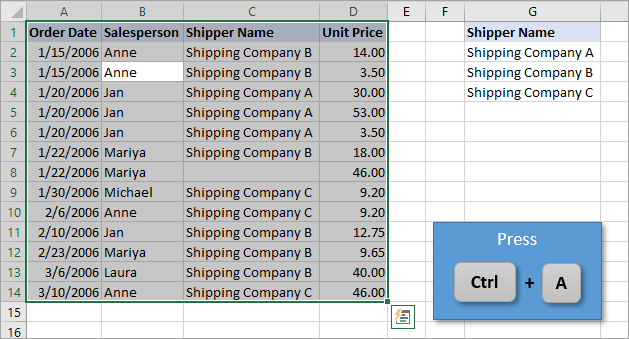Sometimes we need to select the column but only the used range, instead of the whole column.
We can do it with mouse if the data size if not so big.
However, using a mouse could be really time-consuming when you have thousands of rows on your Excel sheets. It can really piss one off if one accidentally release one’s finger when selecting the cells.
In this article, I am going to show you how to select column to end of data. The same concept applies to rows. I will provide you with 4 ways to deal with different situations.
Comparison (4 ways)
I will be showing you 4 ways to select to end of column from a cell. Here I want you to take a look at the comparison table.
Each method has its edges and drawbacks. You can pick one that is most suitable for you.
If you are keen to learn, I suggest you memorising all this.
| Method | Edge | Drawback |
|---|---|---|
| Ctrl Shift Arrow | Time-efficient when the range is contiguous | Time-consuming if there are too many empty cells within the data |
| Ctrl End | No need to guess the last row | Time-consuming if there are too many empty cells within the data |
| Go To | Time-efficient when the range is non-contiguous | Need to estimate how many rows there are |
| VBA | Almost always fastest once created | Take time to create the script |
Example
In this article, I will be illustrating how to select columns/rows to the end of the data by this example.
Most of you may have learnt that the shortcut key to select columns to the end of data is Ctrl + Shift + down arrow.
I would like to add some complexity to the situation by adding some blank cells in between different rows.
As you can see, the end of column A is Cell A15.
In Cell A1 to Cell A15, there are a couples of empty cells, which means the data is not contiguous.

Sample Workbook
Here is a Excel document you can interact with. You can play with it a bit to practise the trick.
Download the workbook to practice it by yourself!
Expected Outcome
We would like to select Column A to the end of the data (Cell A15).

1. Select column to end of data by Ctrl Shift Arrow
Step 1: Select your starting cell
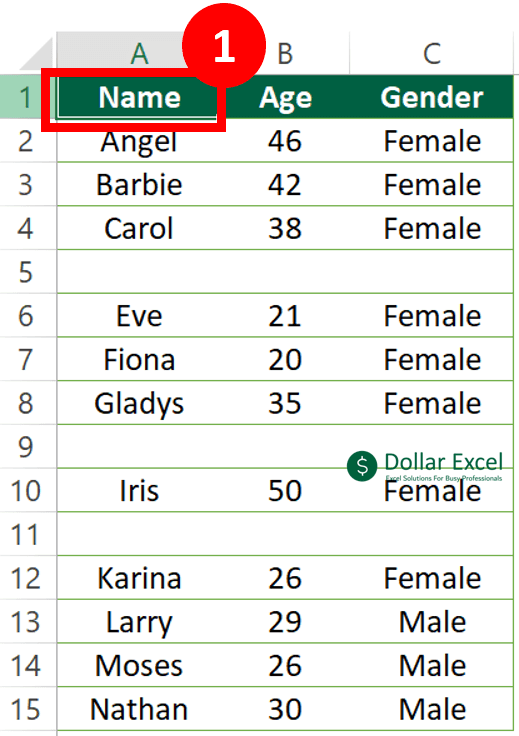
Step 2: Press Ctrl + Shift + down arrow (don’t release any of them)
In the Gif, I am pressing down arrow one at a time to show you how it works.
When you actually use it, you can keep pressing the down arrow key and release it once you find the last row.
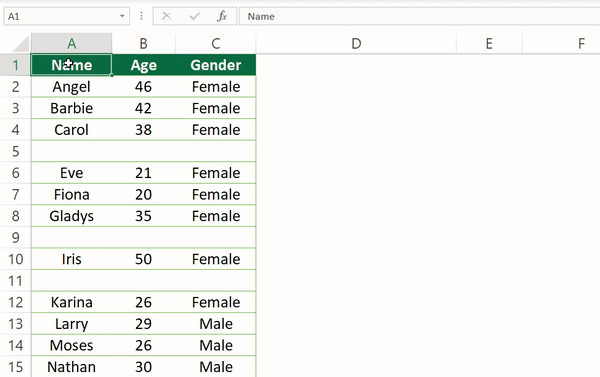
Step 3: Release all 3 keys after you select the range to the end of data
You are done.
The first method is the most straightforward one. All you need to do is just repeating the normal shortcut key.
2. Select column to end of data by Ctrl End
This one is a variation of option 1.
The concept is similar to option 1 but it is slightly different.
Step 1: Press Ctrl End
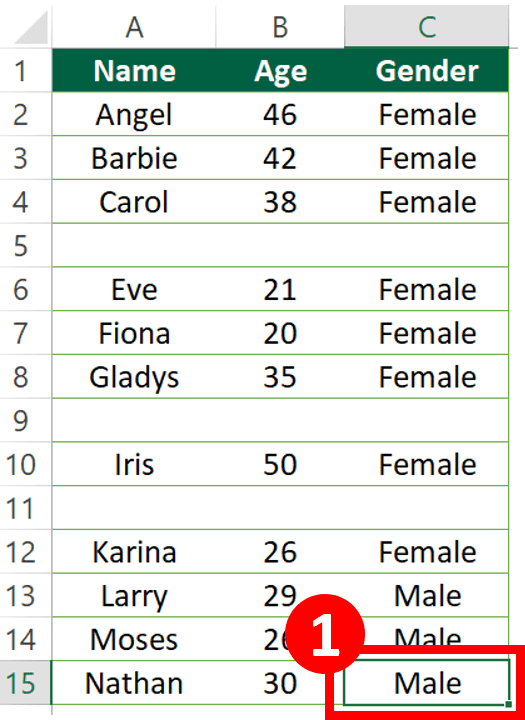
Step 2: Press Ctrl + Left Arrow until you reached Column A
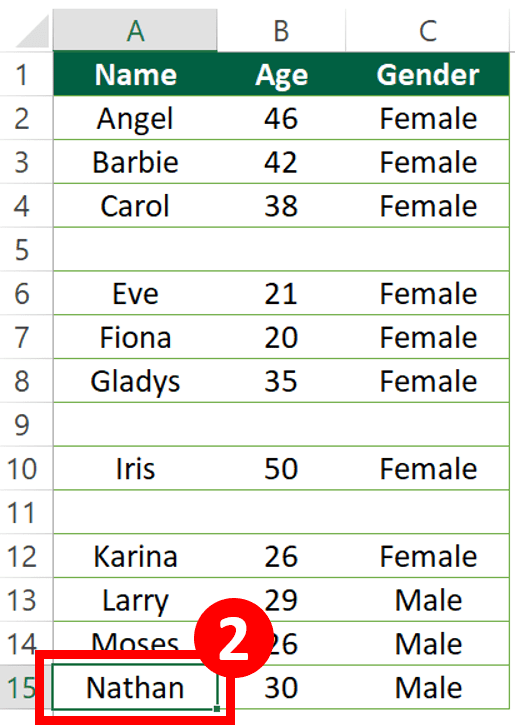
Step 3: Press Ctrl + Shift + Up Arrow until you reached your starting cell
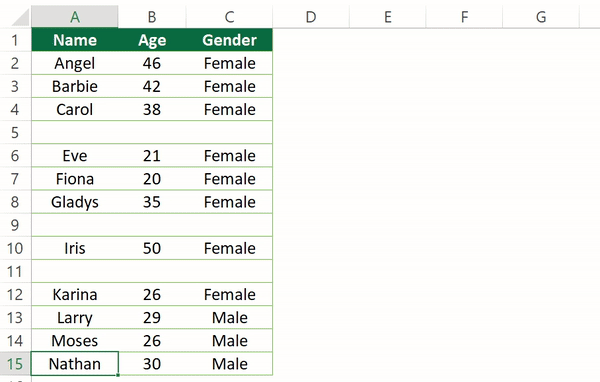
You may consider the option 2 a bit redundant since we already have option 1.
I will tell you why it is not.
When we are using option 1, we cannot press the Ctrl + Shift + down arrow too fast since we are usually unsure of where is the end of the column.
On the contrary, we can keep pressing the Ctrl + Shift + up arrow without releasing it when using the option 1. This is because usually the start of the column is cell A1.
That is why option 2 comes in more handy in most of the time.
3. Select column to end of data by Go To
Step 1: Spot the last cell in the column
You don’t need to select the cell. You just need to know which cell is the last cell in the column.
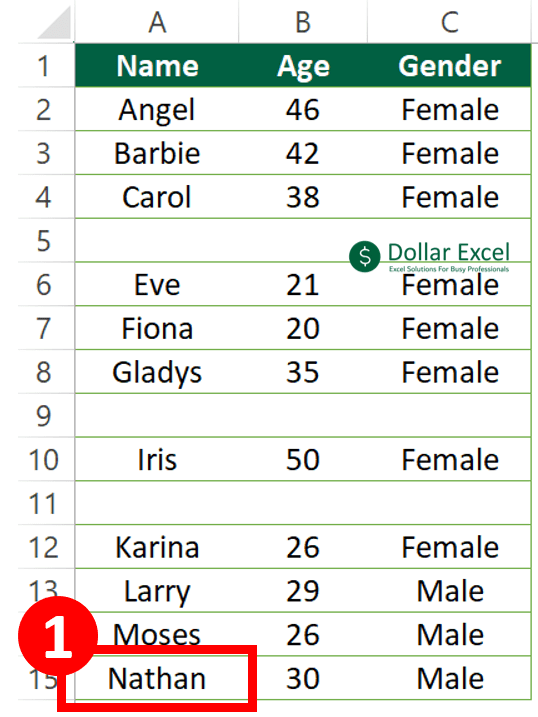
Step 2: Press Ctrl + G to open the “Go To” dialog

Step 3-4: Type the cell range into the reference box and press “OK”

You have reached the end of the column at a few keystrokes. Now you can repeat the ctrl + shift + up arrow.
You may wonder why we would use this Go to dialog when we already have Ctrl + End.
This is because Go to dialog actually gives you greater flexibility.
With Ctrl End, the last cell used in the current Excel worksheet is selected.
With Go to dialog, you can select any of the cell at your own wish.
For instance, I would like to select cell A1 to cell A2345. The end of the column is actually cell 3000.
In this case, Go to dialog is more handy.
4. Select column to end of data by VBA
Read How to Insert & Run VBA code in Excel – VBA101 if you don’t know how to use the VBA code.
The logic here is to select the Cell A1048576.
Since Excel only has 1048576 rows, without a doubt Cell A1048576 is in the last row.
End(xlUp) works like the Ctrl + Shift + Up Arrow shortcut. This step helps you to locate the last non-blank cell in the column.
Next, the code select from Cell A1 all the way to the last non-blank cell.
Sub select_until_end_of_data()
'The script is created by Dollar Excel.
'Subscribe to Dollar Excel newsletter for more free resources like this.
Range("A1048576").End(xlUp).Select
Range(Cells(1, 1), Selection).Select
End Sub
Customize your VBA code
To select column B
Range("B1048576").End(xlUp).Select
To select row 1
Range("XFD1").End(xlToLeft).Select
Other VBA articles
How to Check/Test if Sheets Exist in Excel?
How To List All Worksheets Name In A Workbook
Do you find this article helpful? Subscribe to our newsletter to get exclusive Excel tips!
Most of us work with tabular data in Excel where the data is arranged in columns.
And one of the common tasks most Excel users have to do is to go to the end of the data in the column (i.e., the last filled cell).
While you can quickly go to the end of the column to the last filled cell, or select the entire column till the last filled cell with an easy keyboard shortcut, things can get a bit complicated if you have blank cells in the column.
In this tutorial, I will show you a couple of simple methods (including keyboard shortcuts) that you can use to quickly select the end of the column in Excel.
The method you choose would depend on how your data is structured, and I’ll make sure to mention the pros and cons of each method that I covered in this tutorial.
Keyboard Shortcut to Select the End of the Column (CONTROL + SHIFT + Arrow Key)
Below, I have a data set where I have the items in column A and I have the expenses made every day in column B, and I want to select all the expense values in column B.
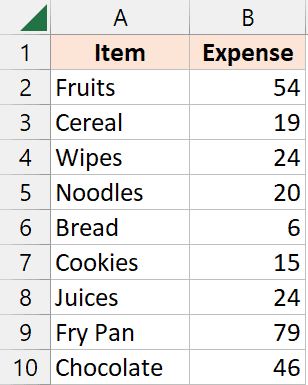
If your data set has no blank cells in any of the cells in the column, you can easily select till the end of the column by using the below keyboard shortcut:
Control + Shift + Down Arrow Key
To use the above keyboard shortcut:
- Select the first cell that you want to be a part of the selection (cell B2 in this example)

- Hold the Control key and the Shift key (together)
- With the Control and Shift key pressed, press the down arrow key once
With the above keyboard shortcut, Excel would magically start the selection from the first selected cell and extend it till the last filled cell in the column.

But life ain’t perfect, and the same can be said for your data in Excel.
Often, data in columns have blank cells that can complicate selecting the entire column till the last filled cell.
When there are Blank Cells in the Column
Below I have the same data set but there are some blank cells in column B, and I want to start with cell B2 and select till the end of the data in the column.

With this data set, if you try and use the above keyboard shortcut, you would notice that the selection is made only till the cell before the first empty cell.

So we need to use the same keyboard shortcut a little differently.
Below are the steps to select till the end of the data in a column when you have blank cells in the column:
- Select the first cell from which you want the selection to begin (cell B2 in our example)
- Hold the Control and the Shift key
- Press the down arrow key, and keep it pressed
- Once you have reached the end of the column in the worksheet, press the up arrow key (while still holding the Control and the Shift key)
While this is not the most elegant solution, it gets the work done, and if you do not have a lot of blank cells in your column, it could be quite fast.
One scenario where this may not be the best method to use is when you have a lot of blank cells (say a blank cell in every other row or after every two or three rows). While the method would still work in such a scenario, it could take a few more seconds (which in my experience is not something most Excel users are willing to give).
Also read: Select Every Other Row in Excel
Keyboard Shortcut to Select the End of the Column (CONTROL + SHIFT + End)
Below, I have a data set where I want to select all the expense values in column B.

Here is another keyboard shortcut that you can use to select the end of the data in a column:
Control + Shift + End
Below are the steps to use this keyboard shortcut:
- Select the first cell from which you want the selection to begin (cell B2 in our example)
- Hold the Control and the Shift key
- Press the End key
The above steps would start the selection from cell B2, and select all the cells till the last used cell.
In most cases, the last cell in your column would also be the last used cell, so this keyboard shortcut should work perfectly in selecting the end of the data in the column.
And the great thing about this method is that you do not need to worry about blank cells, as it selects all the cells between the first selected cell and the last used cell.
When You Have More Data On the Right
When you use Control + Shift + End, it starts the selection from the cell that you selected (B2 in our example), and extends the selection till the last cell in the used range.
So if you have more data on the right of the column, using the above keyboard shortcut would not only select the existing column but also any data that Is to the right,
And sometimes, the used range would remain in the memory of Excel even if you have deleted that data. For example, if I enter some value in the cell E20 and then delete it, the used range in excel would be A1:E20 (as E20 is the last used cell in the memory of Excel).
So there is a possibility that when you use the above keyboard shortcut, it selects more cells on the right and below the column that we intend to select.
In such a scenario, you can use the same keyboard shortcuts with a minor twist:
- Select the first cell from which you want the selection to begin (cell B2 in our example)
- Hold the Control and the Shift key
- Press the End key
- If additional blank rows and columns have been selected, keep the Control and Shift keys pressed, press the Left key once, and then press the Up arrow key once
- Hold the Shift key and keep pressing the left arrow key till only the column that you need is selected.
While this is not the most elegant solution, when you get used to it, you will find it faster than manually selecting a column till the end of the data.
Using the Name Box
Name Box allows you to quickly select a range of cells by entering the reference in the name box.
You will find the name box on the left of the formula bar, just below the formula bar.

Let’s say that I want to select column A (starting from cell A2) till the last filled cell, where I have blank cells in the column (which will make using the keyboard shortcut Control + Shift + Down arrow key challenging).
Below are the steps to use the name box to select the entire column A till the end of the data (i.e., till the last filled cell):
- Place the cursor in the Name Box
- Enter the below cell reference in the Name Box – A2:A1048576

- Hit the Enter key. This will select all the cells in the specified range
- Hold the Control and the Shift key and then press the Up-arrow key.
The above steps would select all the cells in column A till the last filled cell.
Note: This method works in Google Sheets as well (you can use the exact same steps)
Using Go To Dialog Box
Just like the Name Box, you can also use the Go To dialog box to quickly select a range of cells by specifying the reference of that range
Let’s say I want to select the range B2:B100.
Below are the steps to do this using the Go To dialog box
- Go to the worksheet where you want to select this range
- Press the F5 key on your keyboard. This will open the Go-To dialog box

- Enter the below cell reference in the Reference field
B2:B100

- Click OK
There were steps that would instantly select the range that you specified in the Go-To dialog box.
So these are some of the shortcut ways you can use to quickly select data in a column till the end of the data.
While the methods I’ve covered here have been shown using data in a column, you can use the same methods to select data till the end of the rows as well
While you always have the option to do this manually using the mouse, if you need to do this quite often, knowing these shortcuts will significantly improve your efficiency.
Other Excel articles you may also like:
- 7 Easy Ways to Select Multiple Cells in Excel
- How to Select Non-adjacent cells in Excel? (4 Easy Ways)
- How to Deselect Cells in Excel (An Easy Way)
- [Quick Tip] How to Select 500 cells/rows in Excel (with a single click)
- 3 Quick Ways to Select Visible Cells in Excel
- How to Select Every Third Row in Excel (or select every Nth Row)
- How to Quickly Select a Far-off Excel Cell or Range
In this article, we will learn how to select an entire column in excel and how to select whole row or a table using keyboard shortcut keys. While preparing reports and dashboard in Excel, it’s time-consuming to select an entire column using the mouse. These excel shortcuts are useful to save time and help you do your work faster using the keyboard shortcut keys. How to select row with the Excel shortcut?
Selecting cells is a very common function in Excel. It performs many tasks like addition, deletion and width adjustment of multiple rows and columns while applying the formula on data in Excel. Shortcut keys to select all rows and columns can provide an easier and quicker method of using MS Excel 2016. We have a data set here, let’s understand with the example.
How to Select Column in Excel Using Keyboard Shortcuts (CTRL+SPACE)
While navigating on an excel sheet with large data, excel column selection is very basic yet important task. Let’s see how easy is selecting columns in excel.
- Select any cell in any column.
- Press Ctrl + Space shortcut keys on the keyboard. The whole column will be highlighted in excel to show the selected column, as shown below in the picture. You can also say that this is a shortcut to highlight column in excel.
If you wish to select the adjacent columns with the selected column, use Shift + Left/Right arrow key(s) to select entire columns left or right of that column. You can go either way but can’t select both sides of column.
Let’s Select Entire Columns C to E
- To Select Column C:E, Select any cell of the 3rd column.
- Use Ctrl + Space shortcut keys from your keyboard to select column E (Leave the keys if the column is selected).
- Now use Shift + Right (twice) arrow keys to select columns D and E, simultaneously.
- You can select columns C:A by using shortcut Shift + Left (twice) arrow keys.
- You can select columns to the end of sheet using Ctrl+Shift + Left shortcut.
- To select to end of column from a cell, use excel shortcut Ctrl+Shift + Down arrow.
You can’t select columns A:E if you start from any column in between. I am repeating, you can only select entire columns in Excel from left or right of initial column.
How to Select Entire Row Using Keyboard Shortcuts in Excel (SHIFT+SPACE)
This command is used for selecting rows in excel. This is also a shortcut to highlight a row in excel.
- Select the cell in the row you wish to select.
- Press Shift+ Space key to select the row on the selected cell (release the keys, if the row is selected).
- If you wish to select the adjacent rows with the selected row, press Shift+ Up/down arrow key(s) to select the UP or DOWN to that row. You can go either way but can’t access both sides of it.
Selecting 3rd to 5th whole rows of the sheet can be done in two ways:
- Select any cell of the 3rd row, press Shift + Space key to select the row.
- Now use Shift + Down(twice) arrow key to select the 4th and the 5th row.
- Or you could go another way from 5th to 3rd row but you won’t be able to select 3rd and 5th row both, starting from the 4th row.
Select multiple rows and columns of a table with shortcut keys and perform your tasks efficiently.
Frequently Asked Question:
How to apply formula to entire column?
Easy, write a formula in the first cell of column and press CTRL + SPACE to select entire column and then CTRL+D to apply formula to entire column.
How to select all in excel?
To select all data press CTRL+A.
How to highlight a row in excel?
Just select any cell in the row you want to highlight and Press Shift+ Space.
How to select multiple cells in Excel mac?
Hold down the command key and scroll over the cells to select. If the cells are not adjacent then click on the cells while holding the command key.
Hope you understood how to select columns and rows with shortcuts in Excel. You can perform these tasks in 2013 and 2010. Explore more links on shortcut keys here. If you have any query, please mention in the comment box below. We will help you.
If you liked our blogs, share it with your friends on Facebook. And also you can follow us on Twitter and Facebook.
We would love to hear from you, do let us know how we can improve, complement or innovate our work and make it better for you. Write us at info@exceltip.com
I am trying to make a macro that selects certain data in my sheet. I have a sheet with data that is pulled into it using:
Windows("Item checkout workbook_New.xlsx").Activate
Range("A2:G300").Select
Selection.Copy
Windows("VLookup test.xlsx").Activate
Sheets("Sheet1").Select
Range("A2:G2").Select
ActiveSheet.Paste
Application.CutCopyMode = False
Sheets("Sheet1").Range("A2:G300").Copy Sheets("Sheet2").Range("A2")
Sheets("Sheet2").Select
Application.CutCopyMode = False
Once this data is input, I have two columns H2:H300 and I2:I300 that has formulas already in it for Vlookup that get information from A2:G300.
What I then need to do is select only the relevant data and copy it back to Windows("Item checkout workbook_New.xlsx"). By relevant data, I need to select only cells with data in the A2:G300 range as well as the H2:I300 cells that match. Seeing as ALL H2:I300 cells have data, I am not sure how to do this. I tried to create a macro that uses END to select all of column A and then the rows that go with it, but this is what I got and as you can see it will not work:
Range("A2").Select
Range(Selection, Selection.End(xlDown)).Select
Range("A2:I78").Select
Selection.Copy
I am not great at VBA thus it is hard to come up with things on the fly, but I feel like there should be a way to get this to work. Any advice would be great!
Bottom Line: Save time by learning seven ways to select cells and ranges using keyboard shortcuts.
Skill Level: Beginner
Video Tutorial
Download the Excel File
If you’d like to follow along with the video using the same worksheet I’m using, you can download it here:
Keyboard Shortcuts to Select Cells
Who doesn’t love a keyboard shortcut to help make things faster and easier? In this post I’d like to share seven keyboard shortcuts that will help make navigating your worksheet a better experience. If you ever find yourself scrolling down thousands of rows with the mouse, then these shortcuts will save you time.
1. Select the Last Used Cell
The keyboard shortcut to select the last used cell on a sheet is: Ctrl+End
No matter where you start from in your worksheet, Ctrl+End will take you to the intersection of the last used column and last used row.
Sometimes, when you use this shortcut, Excel will move your selection so that is farther to the right or farther down than the data range you can see.
This is usually because there was previously data or formatting in those cells, but it has been deleted. You can clear that by deleting any of those previously used rows or columns and then saving your workbook. (Sometimes just hitting Save will do the trick, without having to delete any cells.)
Ctrl+End will select the last used cell on the sheet. However, there could be shapes (charts, slicers, etc.) on the sheet below or to the right of that cell. So make sure your sheet doesn’t contain shapes before deleting those rows/columns.
2. Select the First Visible Cell
The keyboard shortcut to select the first visible cell on a sheet is: Ctrl+Home
Using Ctrl+Home will always take you to the first visible cell (excluding hidden rows/columns) on the sheet, unless your sheet has Freeze Panes.
Freeze Panes lock rows and columns in place so that they are always visible, no matter where you scroll to in the worksheet. Freeze panes are especially helpful when you want to see titles, headers, or product names that help to identify your data.
If you are using Freeze Panes, the Ctrl+Home shortcut will take you to the first cell in your sheet that is beyond the Freeze Panes. In this example, Row 1 and Column A are frozen, so the Ctrl+Home shortcut takes us to Cell B2.
3. Select Last Cell in Contiguous Range
The keyboard shortcut to select the last cell in a contiguous range is:
Ctrl+Arrow Key
Using Ctrl along with your arrow keys allows you to move to the beginning or end of contiguous data in a row or column. For example, if you start at the top of a column and then press Ctrl+? you will jump to the last cell in that column before an empty cell. Repeating this process will move you further down the column to just before the next blank cell.
Ctrl+? will reverse that process in the upward direction. And of course, holding Ctrl while using the left or right arrow key accomplishes the same action horizontally instead of vertically.
An Alternative Using the Mouse
You can accomplish this same action using your mouse instead of the keyboard, if you like. Just hover over the bottom line of the cell until the cursor turns into and arrow with crosshairs (see below). Then double-click. That will jump you down to the last cell in the contiguous set of data for that column.
4. Add Cells to the Selected Range
The keyboard shortcut to add cells to the selected range is: Shift+Arrow Key
If you use Shift along with your arrow keys, you can select multiple cells, one at a time. For example, if you start in any cell and press Shift+?, it highlights the original cell and the cell just below it.
The same idea applies to the left, right, or up arrows. And if you keep the Shift key held down, you can continue to move over multiple cells in multiple directions to select an entire range of data.
5. Select Multiple Cells in Contiguous Range
The keyboard shortcut to select multiple cells in a contiguous range is:
Ctrl+Shift+Arrow Key
Using the same process as in Shortcut 3, but adding the Shift key, allows you to select multiple cells simultaneously. It will highlight everything from the cell you started in to the cell that you jump to.
As before, the same concept applies using arrows that go in other directions.
This process only selects cells that come before a blank cell. However, sometimes a column can have many blank cells. If so, this method may not be your best option. To select large amounts of data containing many blanks, I recommend checking out this post for some alternatives:
2 Keyboard Shortcuts to Select a Column with Blank Cells
6. Select All Cells to First or Last Cell
Shortcuts 1 and 2 taught us how to jump from whatever cell we are in to the beginning corner (Home) or ending corner (End) of our data range. Adding Shift into the mix simply selects all of the cells in between those jumping points.
So if, for example, we start in Cell C5 and Press Ctrl+Shift+Home, the following range will be selected.
The keyboard shortcut to all cells to from the active cell to the first visible cell is:
Ctrl+Shift+Home
If instead we were to begin at C5 and press Ctrl+Shift+End, this range of data will be selected:
The keyboard shortcut to all cells to from the active cell to the last used cell is:
Ctrl+Shift+End
7. Select All Cells
The keyboard shortcut to all cells in the current used range is: Ctrl+A
Press Ctrl+A a second time to select all cells on the sheet.
If your spreadsheet has multiple blocks of data, Excel does a pretty good job of selecting the block of data that is surrounding your cell when you press Ctrl+A. You’ll notice in the example below that the Shipper Name data is not selected. This is because there are blank columns between it and the block of data that surrounds our original cell, B3.
If your intention is to select all of the cells on the sheet, you simply press Ctrl+A a second time and your entire worksheet will be highlighted.
The keyboard shortcut to all cells on the sheet is: Ctrl+A,A
Better, Faster, Smarter
I hope you are able to commit some of these shortcuts to memory. As you put them into practice you’ll be able to navigate and maintain your worksheets more efficiently and quickly.
Have a keyboard shortcut that you want to share? Leave a comment below. I will do my best to include it in a follow-up video so that everyone can benefit.







